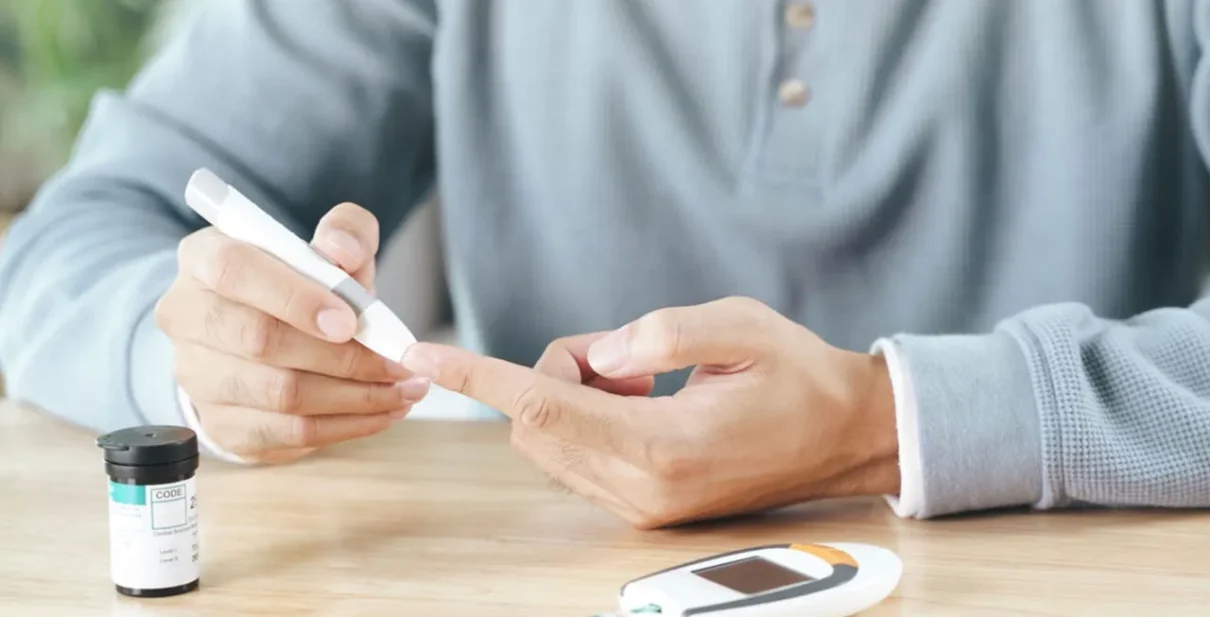The Diabetes Management Revolution
Diabetes management has transformed dramatically over the past few decades. What once required laboratory visits and hours of waiting can now be accomplished in seconds at home. Let’s explore how modern blood glucose monitoring systems are changing lives.
The Technology Behind Modern Glucometers
Today’s blood glucose monitors use advanced biosensor technology that combines:
Enzyme-Based Detection
Modern test strips use glucose oxidase or glucose dehydrogenase enzymes that react specifically with glucose in blood. This enzymatic reaction produces an electrical current proportional to the glucose concentration.
Minimal Sample Requirements
Early glucometers required large blood drops. Today’s systems like the AccuSure need only 0.5 µl (microliters) – about the size of a pinhead. This means:
- Less pain for patients
- Easier testing for children and elderly
- Possible testing from alternative sites (forearm, palm)
- Reduced anxiety about testing
Key Features That Matter
Speed: 8-Second Results
Modern glucometers provide results in just 8 seconds. This rapid feedback:
- Encourages more frequent testing
- Allows quick decision-making about insulin dosing
- Makes testing less disruptive to daily activities
- Improves patient compliance
Memory and Data Management
Advanced systems store up to 1000 test results with date and time stamps. This feature enables:
- Tracking blood sugar patterns over time
- Identifying trends and problem times
- Sharing data with healthcare providers
- Better treatment adjustments
- Improved long-term glucose control
Before/After Meal Markers
The ability to tag readings as before or after meals helps:
- Understand food impact on blood sugar
- Adjust meal planning
- Optimize insulin timing
- Identify problematic foods
- Achieve better overall control
Ketone Warning Function
Built-in ketone warnings alert users to potential diabetic ketoacidosis (DKA), a serious complication. Early warning means:
- Prompt medical intervention
- Prevention of emergency situations
- Increased patient safety
- Peace of mind for users and families
ISO Standard Conformity: What It Means
Modern glucometers must meet ISO 15197:2013 standards, which require:
- 95% of results within ±15 mg/dL for glucose <100 mg/dL
- 95% of results within ±15% for glucose ≥100 mg/dL
- Testing range typically 20-600 mg/dL
This standardization ensures reliable results across different brands and models.
Strip Technology: The Unsung Hero
Extended Shelf Life
Modern enzyme strips offer:
- 18-month expiry from manufacturing
- 24-month shelf life when properly stored
- Stability in various climatic conditions
- Reduced waste and cost
No Coding Required
Older systems required manual code entry for each new strip vial. Modern auto-coding technology:
- Eliminates user error
- Simplifies testing process
- Improves accuracy
- Makes testing more accessible
Alternative Site Testing: Less Pain, More Testing
The ability to test from alternative sites like the forearm or palm:
- Reduces fingertip pain and calluses
- Encourages more frequent monitoring
- Improves quality of life
- Maintains accuracy when properly done
Important Note: Fingertip testing is still recommended when:
- Blood sugar is changing rapidly
- Before driving
- When experiencing hypoglycemia symptoms
- Before exercise
Choosing the Right Glucometer
Consider these factors:
For Active Individuals:
- Compact, portable design
- Quick results (8 seconds or less)
- Alternative site testing capability
- Durable construction
For Elderly Users:
- Extra-large display
- Simple one-button operation
- Audio features (if available)
- Easy strip insertion
For Tech-Savvy Users:
- Data connectivity options
- Comprehensive memory
- Trend analysis features
- Integration with health apps
For Budget-Conscious Buyers:
- Affordable strip costs (most important ongoing expense)
- Reliable accuracy
- Lifetime or long warranty
- Local service availability
Proper Testing Technique
To ensure accurate results:
- Wash and dry hands thoroughly – Residue can affect readings
- Use fresh lancet – Reduces pain and contamination risk
- Test from side of fingertip – Less painful than pad
- Apply adequate blood sample – Insufficient sample causes errors
- Test at recommended temperature – Extreme temperatures affect accuracy
- Check strip expiry – Expired strips give false readings
- Maintain the meter – Regular cleaning and calibration
Common Testing Errors to Avoid
Environmental Factors:
- Testing in extreme temperatures
- High humidity affecting strips
- Direct sunlight on meter
- Altitude changes (initially)
User Errors:
- Dirty or wet hands
- Insufficient blood sample
- Using expired strips
- Improper strip storage
- Not calibrating when required
Technical Issues:
- Low battery power
- Contaminated meter
- Damaged test strips
- Using wrong strip type
When to Test
Healthcare providers typically recommend testing:
Type 1 Diabetes:
- Before meals and snacks
- Before and after exercise
- Before bedtime
- During the night (occasionally)
- When feeling symptoms
- Before driving
Type 2 Diabetes (Insulin-dependent):
- Based on insulin regimen
- Before meals
- Before bedtime
- As recommended by doctor
Type 2 Diabetes (Non-insulin):
- As recommended by healthcare provider
- When starting new medications
- When adjusting diet or exercise
- When experiencing symptoms
The Future of Glucose Monitoring
Emerging technologies include:
- Continuous glucose monitors (CGMs)
- Non-invasive monitoring systems
- Smartphone integration
- Artificial pancreas systems
- Predictive algorithms
- Cloud-based data management
Cost Considerations
While the meter itself may be affordable or even free, consider:
- Strip cost: The main ongoing expense
- Testing frequency: More testing = higher costs
- Insurance coverage: Check what’s covered
- Bulk purchasing: Can reduce per-strip cost
- Warranty: Lifetime warranty protects investment
Making Testing a Habit
Tips for consistent monitoring:
- Set phone reminders
- Keep meter easily accessible
- Pair testing with routine activities
- Log results immediately
- Share data with healthcare team
- Celebrate good control
Quality Matters in Test Strips
Always use:
- Manufacturer-approved strips
- Strips within expiry date
- Properly stored strips (sealed until use)
- Strips from reliable suppliers
Generic or counterfeit strips may:
- Give inaccurate results
- Damage your meter
- Void warranty
- Compromise diabetes management
The Bottom Line
Modern blood glucose monitoring systems have made diabetes management more accessible, less painful, and more effective than ever before. The combination of speed, accuracy, and user-friendly features empowers patients to take control of their health.
Choosing a quality glucometer with reliable test strips from a trusted supplier is essential for accurate diabetes management. Look for systems that meet ISO standards, offer comprehensive features, and come with solid warranty support.
Ready to upgrade your glucose monitoring system? Contact FMB Healthcare Systems for expert guidance and quality products.



